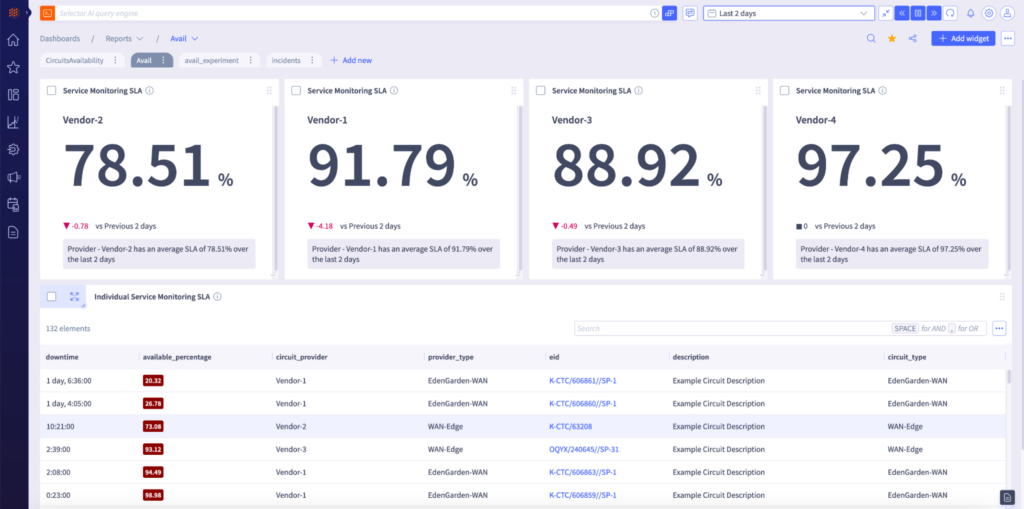Network performance plays a key role in service delivery, acutely impacting user experience. However, enterprise teams have long struggled with comprehensive insight into network performance and, when necessary, the ability to hold circuit vendors accountable.
Fortunately, Selector’s advances in network monitoring and observability support detailed visibility into circuit performance, making it possible to establish service level agreements (SLAs), service level objectives (SLOs), and service level indicators (SLIs) for circuits. These correspond to the promises organizations make to their customers, the internal objectives that help organizations keep those promises, and the direct measurements organizations use to assess their performance.
In fact, Selector can collect and analyze telemetry from your full-stack, delivering insight into SLAs, SLOs, and SLIs for network, but also infrastructure, cloud, and application as well.
Network Reliability as a Discipline
SLAs, SLOs, and SLIs are used extensively within the discipline of site reliability engineering. However, the network domain has been historically underserved. Innovations in tooling, philosophies, and practices oriented around reliability and performance are largely applied elsewhere. Fortunately, we can learn from these innovations to improve delivery of the network.
For instance, in the infrastructure and application spaces, we have the concept of a site reliability engineer (SRE). This role has become table stakes for any enterprise looking to competently deliver a service. In contrast, network reliability engineers (NREs) remain relatively uncommon. NRE responsibilities are similar to those of SREs, but specifically adapted to measuring and stabilizing the reliability of the network to align with enterprise goals.
A likely reason for the obscurity of NREs as well as the absence of impactful practices such as circuit SLAs, SLOs, and SLIs, has been insufficient data and tooling. However, the tide has turned. Selector’s unified monitoring, observability, and AIOps platform is uniquely positioned to provide teams with essential insight into network health and performance.
Measuring Circuit Performance with Selector
To achieve a comprehensive view of network performance, circuit performance must be taken into account. Selector helps operators assess circuit performance by providing unprecedented visibility into circuit KPIs such as latency, jitter and error rate.
Clients benefit from an integrated network monitoring solution, accessible through a unified dashboard, that replaces key functionality historically addressed by multiple tools. Most crucially, Selector’s platform assists operators with defining and continuously monitoring their SLAs, SLOs, and SLIs.
To measure SLA compliance, for instance, Selector first defines the SLA with respect to circuit KPIs such as throughput, latency, jitter, errors, uptime, flaps, etc. These KPIs are then combined to calculate an overall SLA score. Selector will even adjust the score to take into account any maintenance windows published by circuit providers. For instance, if a provider announces they will be down for six hours due to system maintenance, that downtime will be excluded from the SLA calculation.
In the image below, a client is using a Selector dashboard to track circuit performance from several different network providers, revealing compliance across multiple kinds of links that are available in a particular location.

At the top of the dashboard, each SLA card displays the aggregate performance across all the circuits offered by a given vendor. As you can see, all 100+ connections provided by Vendor-2 are summarized within the first card, on the upper left. According to this snapshot, the client can see that Vendor-2 is only meeting their contractual commitments 78.51% of the time, which depending on the agreement, may be grounds to receive credits back or trigger termination of that contract. Clients can also select a time period, such as a calendar month, over which to view SLA or SLO compliance as articulated within the commitment or agreement.
The table below the cards lets customers investigate specific circuits of interest. For example, users can sort by circuit downtime or circuit availability—our tool provides a ranked list of metrics from best to worst. Clicking on the circuit ID enables users to drill down into a detailed view of the various KPIs related to a given circuit (jitter, latency, throughput etc.), allowing operators to pinpoint specific issues and determine why a given circuit might be failing its SLA.
A Trusted Third-Party Assessment of Circuit Performance
Selector delivers key circuit performance data directly to clients, so they no longer need to rely on reporting from vendors. In essence, Selector provides a neutral, third-party assessment of circuit performance and circuit SLA compliance.
Once compliance insights are generated, Selector can consolidate them into a report and send it to internal and external stakeholders.These reports, which can be generated daily, weekly, monthly, or quarterly, facilitate collaboration and decision-making within an organization.
For instance, management or procurement might be interested in learning more about which circuit vendors are performing best, so they can confidently renew those relationships. Alternatively, these teams may want to know which circuit vendors are underperforming, so they can replace them or negotiate a discount.
Choose Success
The scale and complexity of network infrastructure continues to grow, as well as the demands placed on it by service providers and their end-users. Operators must rise to the challenge, building and maintaining resilient network solutions that prioritize reliability, availability, and performance. Now, more than ever, these teams must select the appropriate tooling to support their efforts. With robust monitoring capabilities and an impressive suite of AI/ML-powered features, Selector helps operators not only meet today’s rigorous scalability demands, but prepare for those of tomorrow. What’s more, Selector can apply these strategies from network to application, and everything in between.